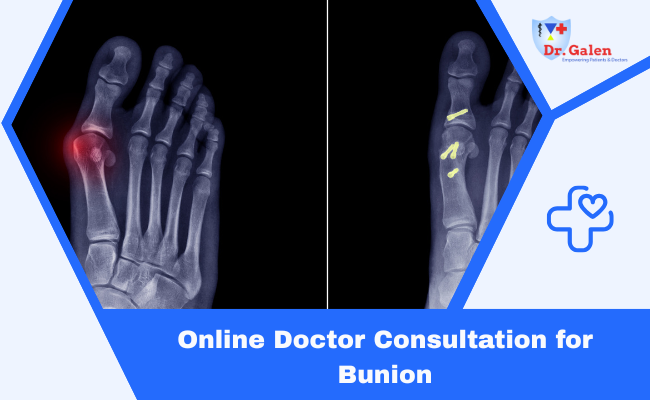What is Bunion?
A bunion, also known as hallux valgus, is a bony bump that forms at the base of the big toe, where it meets the foot. It occurs when the bones in the front part of the foot shift out of place, causing the big toe to push against the next toe. This leads to a swollen, painful, and inflamed joint.
Symptoms of a Bunion
- 1. Bony bump at the base of the big toe
- 2. Pain or tenderness in the toe joint
- 3. Swelling, redness, or soreness around the joint
- 4. Stiffness or limited toe movement
- 5. Corns or calluses between overlapping toes
- 6. Shoe discomfort due to pressure and pain
- 7. Toe deformity as the big toe shifts inward
The Main and Hidden Impacts of Bunions
Bunions primarily cause pain, swelling, and difficulty walking due to the misalignment of the big toe joint. Over time, they can lead to chronic discomfort, reduced mobility, and challenges in finding comfortable footwear. If left untreated, bunions may cause hidden complications like joint inflammation (bursitis), hammertoes, calluses, and even arthritis in the affected joint. The altered foot structure can also impact posture and gait, leading to pain in the knees, hips, or lower back, further affecting overall quality of life.
Consult Our Orthopedic Surgeon / Orthopedist
-
Dr. Timothy Cheng, MBBS, MRCSED : Specializes in orthopedics, focusing on the diagnosis and treatment of bunions.
-
Dr. Vaikunthan Rajaratnam, MBBS (MAL), AM(MAL),... : Board-certified Orthopedic Specialist skilled in diagnosing and treating bunions and foot deformities.
-
Dr. Thomas Falls, MD : Experienced Orthopedic Specialist known for a compassionate approach to bunion care.
Importance and Benefits of Consulting a Orthopedist Online
Consulting an orthopedist is crucial for bunions as they provide accurate diagnosis and tailored treatment plans to prevent worsening deformities, reduce pain, and improve mobility. Bunions, or hallux valgus, are common foot deformities worldwide, with varying prevalence across regions. They are more frequently seen in areas like Oceania and Asia, while lower rates are noted in Africa. In Western countries, a significant portion of the population is affected. Factors such as genetics, age, and footwear choices play a major role in these regional differences.
How Our Platform Connects You with Orthopedic Specialists
Our platform connects you with experienced Orthopedists for accurate diagnosis and effective management of bunions. Easily schedule audio and video consultations, receive personalized treatment plans, and access expert care from the comfort of your home. We are committed to providing a seamless and convenient healthcare experience, ensuring timely care to relieve pain, prevent complications, and improve foot function for long-term comfort.
100% Refund Policy
We value your satisfaction and confidence in our services. If, for any reason, your consultation does not occur, we offer a 100% refund policy to ensure your peace of mind.
FAQ
A bunion is primarily caused by pressure on the big toe joint, leading it to shift out of alignment. Contributing factors include inherited foot structure, wearing tight or high-heeled shoes, foot injuries, arthritis, and conditions like flat feet or overpronation. Over time, this misalignment causes the joint to bulge outward, forming a painful bony bump.
Recovery after bunion surgery typically takes 6 to 12 weeks, depending on the type of procedure and individual healing. Initial healing involves 2 to 6 weeks of limited weight-bearing, often using crutches or a surgical boot. Swelling may persist for several months, and full recovery, including a return to normal activities and footwear, can take up to 6 months or longer. Following post-surgery care and physical therapy helps speed up recovery and improve outcomes.
To prevent bunions from getting worse, wear properly fitted shoes with a wide toe box, good arch support, and low heels to reduce pressure on the joint. Using protective pads or custom orthotics can help cushion the bunion and improve foot alignment. Maintaining a healthy weight reduces strain on your feet, while regular foot exercises strengthen muscles and enhance flexibility. Avoid high heels and tight shoes, as they can worsen the condition. Regularly monitor any changes in size, pain, or swelling and consult an orthopedic specialist if symptoms progress.
No, bunions do not go away on their own. Since they are structural deformities of the foot, they typically worsen over time without proper management. While non-surgical treatments like wearing supportive shoes, using orthotics, and applying ice can help reduce pain and slow progression, surgery is the only way to completely correct a bunion.
